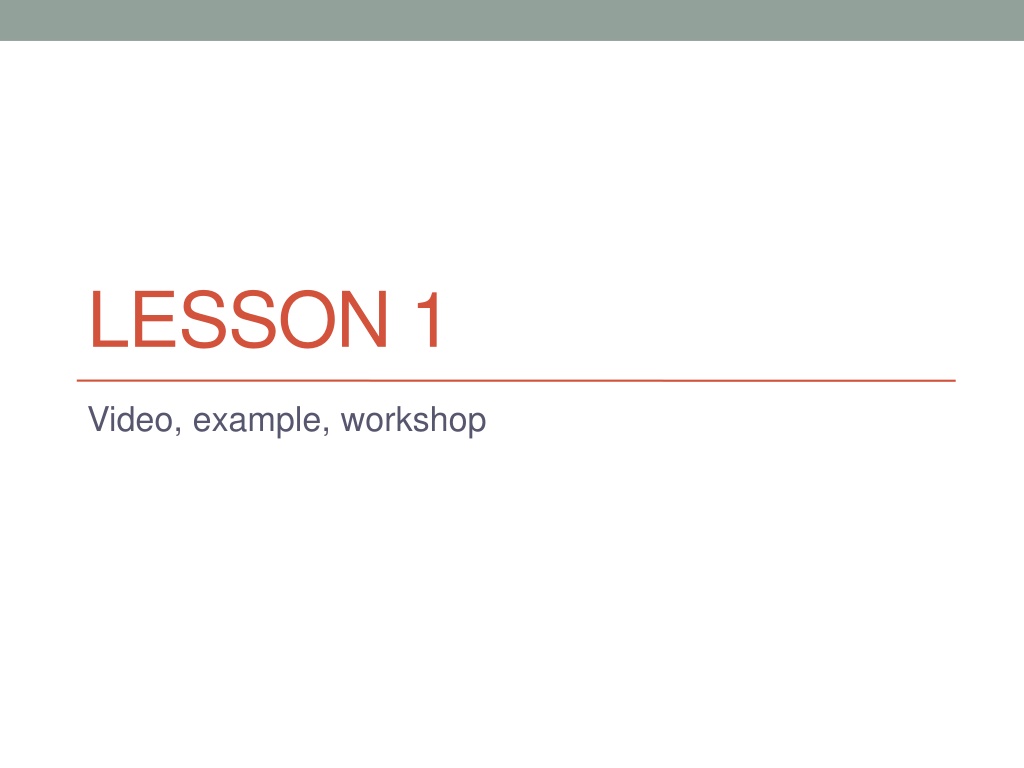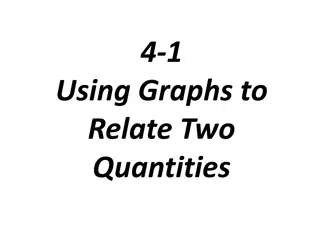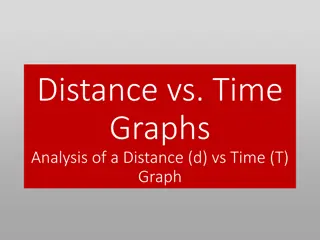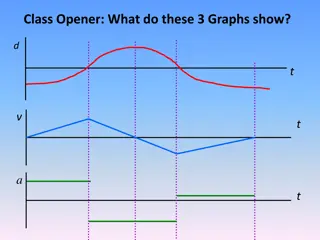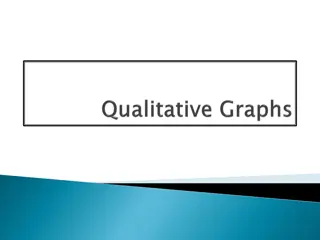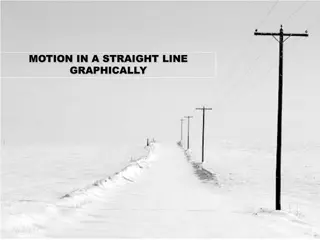Exploring Motion through Elevation-Time Graphs
Dive into understanding motion using elevation-time graphs in this interactive lesson. Analyze the motion of individuals in videos, interpret graphs, and grasp the concept of piecewise-defined linear functions. Engage in practical exercises and workshops to enhance your fluency in representing motion graphically.
Download Presentation

Please find below an Image/Link to download the presentation.
The content on the website is provided AS IS for your information and personal use only. It may not be sold, licensed, or shared on other websites without obtaining consent from the author. Download presentation by click this link. If you encounter any issues during the download, it is possible that the publisher has removed the file from their server.
E N D
Presentation Transcript
LESSON 1 Video, example, workshop
Opening Describe, in words, the motion of the man in the video. http://www.mrmeyer.com/graphingstories1/graphingstories2.mov How high do you think he was at the top of the stairs? Were there intervals of time when his elevation wasn t changing? Did his elevation ever increase? Can we represent this on a graph? How should we label the axes? What units should we use? Where does starting at the top show up on the graph? Show with hands what the general shape should look like.
Example Here is an elevation-v-time graph of a person s motion. Describe what the person might be doing. What is happening when the graph is increasing/decreasing/constant? What does it mean when one part is steeper than another? Is it possible it s a person on a ladder? Hill? What s the average rate of change from 0 to 4 minutes?
Notes Piecewise-Defined Linear Function: When given non-overlapping intervals, a (real) piecewise linear function is the union of the intervals where each is defined by (possibly different) linear functions. Side Note: the non-overlapping intervals might be unclear if it s not obvious which contains the end points. [0,2) [2,5) [5, 10) versus [0,2] (2,5] (5, 10]
Workshop Must Do May Do Classwork exercises a-f Fluency practice 24 Flashcards Integer war Scavenger hunt http://www.mrmeyer.com/graphin gstories1/graphingstories3.mov
LESSON 2 Examples, workshop, notes
Example 1 Describe, in words, the motion shown in the video. https://www.youtube.com/watch?v=MNouL91FVaI Focus on the elevation of the ball and give details linking elevation and time. Focus on general shape Notice the tail at the end Should it be a constant rate?
Workshop Must Do May Do Classwork exercises 1-3 Complete cw #1 Fluency practice 24 Flashcards Integer war I have.. Who has Scavenger hunt https://www.youtube.com/watch? v=ZCFBC8aXz-g http://www.mrmeyer.com/graphin gstories1/graphingstories4.mov
Summary After reflecting these graphs over the y-axis (vertical line), you get graphs like this. Classwork #1 Classwork #2 NOTE: in context, negative portions of these graphs don t always make sense.
Notes When you reflect a curve over a vertical line, you get a parabola, or U-shaped graph, that represents a quadratic function, which has x raised to the second power
LESSON 3 Example, workshop, notes
Example Darryl lives on the third floor of his apartment building. His bike is locked up outside on the ground floor. At 3:00 p.m., he leaves to go run errands, but as he is walking down the stairs, he realizes he forgot his wallet. He goes back up the stairs to get it and then leaves again. As he tries to unlock his bike, he realizes that he forgot his keys. One last time, he goes back up the stairs to get his keys. He then unlocks his bike, and he is on his way at 3:10 p.m. Sketch a graph that shows his change in elevation over time.
Darryl lives on the third floor of his apartment building. His bike is locked up outside on the ground floor. At 3:00 p.m., he leaves to go run errands, but as he is walking down the stairs, he realizes he forgot his wallet. He goes back up the stairs to get it and then leaves again. As he tries to unlock his bike, he realizes that he forgot his keys. One last time, he goes back up the stairs to get his keys. He then unlocks his bike, and he is on his way at 3:10 p.m.
Workshop Must Do May Do Classwork exercise 1 Complete cw #1-2 Fluency practice 24 Flashcards Integer war I have who has Scavenger hunt https://www.youtube.com/watch? v=gEwzDydciWc
Notes When you have a multiplication pattern, you get a curve that represents an exponential function. So far we have looked at 3 types of graphs: linear, quadratic, and exponential and we will spend the next several days (and much of the year) studying how to recognize and use them in real-life situations.
LESSON 4 Example, workshop
Example How is water mainly used at a school? What are the axes for? What causes large spikes? Small spikes? Typical water usage (ignoring large spikes)? Regular school day: 8:00am 3:04pm After School: 3:15 5:15 Around 10am there is a 13 minute advisory period Units on the vertical axis? Typical amount of water used, not including the spikes.
Workshop Must Do May Do Classwork exercises 1-3 Fluency practice Integer war I have who has 24 Flashcards Complete classworks 1-3
LESSON 5 Example, notes, workshop
Example Consider this story and sketch ONE graph of the situation: Maya and Earl live at opposite ends of the hallway in their apartment building. Their doors are 50 ft. apart. Each starts at his or her own door and walks at a steady pace toward each other and stops when they meet.
Notes The intersection point of the graphs of two equations is an ordered pair that is a solution to both equations. In the context of a distance (or elevation) story, this point represents the fact that both distances (or elevations) are equal at the given time.
Workshop Must Do May Do Exit ticket #3-4 Classwork exercises 1-8 Fluency practice 24 Flashcards Integer war Scavenger hunt Create a poster of problems 1-4 http://youtu.be/X956EvmCevI
LESSON 6 Opening, examples, notes, workshop
Opening the 4-number game Use the digits 1, 2, 3, and 4 one or fewer times and addition and multiplication (as well as grouping symbols) to create as many different positive integers as you can. Value Expression Value Expression 1 14 2 15 3 16 4 17 5 18 6 19 7 20 8 21 9 22 10 23 11 24 12 25 13
Opening Discussion We know that 1+2+3=6 AND 1x2x3=6. Is this true for all a, b, c? Is a+b+c always equal to abc?
Example What if, in the 4-number game, we allowed repeated use of symbols. Knowing that 1+2+3+4=10, we can make 110 because 10x10+10 = 110, so (1+2+3+4)(1+2+3+4)+(1+2+3+4) = 110 using addition only? 2) What expressions can you make when repetition is allowed? Now, what if the symbols were 3, x, y, and a (instead of 1, 2, 3, 4). 1) What expressions can you make from these symbols Did anyone, or can anyone, make 4x + 5y + 3a from this?
Notes Distributive property: if a, b, and c are real numbers, then a(b + c)=ab + bc (a+b)2 = a2 + 2ab + b2 (a+b+1)(b+1) = ab + b2 + a + 2b + 1 (a+b)(c+d)(e+f+g) = ace + acf + acg + ade + adf + adg + bce + bcf + bcg + bde + bdf + bdg Collecting, or combining, like terms is an extension of the distributive property. x + x = 2x because: x + x = 1x + 1x = (1+1)x = 2x Terms single numbers, variables, or combinations connected by multiplication (separated by add/subtraction) Like terms terms that have the same variables raised to the same exponents.
Workshop Must Do May Do Classwork exercises 1-5 Independent work
LESSON 7 Opening, notes, example, workshop
Opening Shyanne draws the following picture to represent 3 + 4: Ben looks at the picture from the opposite side of the table and says You drew 4 + 3. Why does Ben interpret it this way?
Opening Shyanne adds more to her picture and says: Now the picture represents (3 + 4) + 2. How might Ben see the picture?
Opening Shyanne then draws another picture of squares to represent 3 x 4. Ben moves to the end of the table and says From my new seat it looks like 4 x 3. What picture did Shyanne draw and where did Ben sit for his view? Challenge: Draw a picture for (3 x 4) x 5 that could also be (4 x 5) x 3 from a different view point.
Notes: The Properties & Definitions COMMUTATIVEPROPERTY: For real numbers, a+b=b+a &a b=b a. ASSOCIATIVEPROPERTY: For real numbers, (a+b)+c=a+(b+c) & (ab)c=a(bc). NUMERICALSYMBOL: represents a specific number. VARIABLESYMBOL: a placeholder for a number. ALGEBRAICEXPRESSION: A numerical symbol, a variable symbol, or a combination using the five main operations NUMERICALEXPRESSION: An algebraic expression that contains only numerical symbols **Two expressions are equivalent if we can convert one expression into the other by applying properties**
Example Viewing the diagram below from two different perspectives illustrates that (3+4)+2 equals 2+(4+3). Is it true for all real numbers x, y, and z that (x+y)+z should equal z+(y+x)?
Example, continued Is it true for all real numbers x, y, and z that (x+y)+z should equal z+(y+x)?
Workshop Must Do May Do Exit ticket #5-6 Classwork exercises 1-5 Complete cw #1-6 Fluency practice 24 Flashcards Integer war Scavenger hunt
LESSON 8 Warm Up, notes, workshop
Warm Up How many quarters, nickels, and pennies are needed to make $1.13? Fill in the blanks: 8,943= _______ 1000 +_______ 100 + _______ 10 + _______ 1 = _______ 103 + _______ 102 + _______ 10 +_______ 1 8,943= _______ 203 +_______ 202 +_______ 20 +_______ 1 113= _______ 52 + _______ 5 + _______ 1
Notes: The Properties & Definitions Monomial:a polynomial expression generated using only multiplication. It does not contain addition/subtraction. Binomial: the sum or difference of two monomials Trinomial: the sum or difference of 3 monomials Polynomial: the sum or difference of any number of monomials (numbers in base x) The degree of a polynomial is the degree of the term with the highest exponent. POLYNOMIALEXPRESSION: A numerical expression or a variable symbol, or The result of connecting two previously generated polynomial expressions using addition or multiplication
Workshop Must Do May Do Classwork exercises 1-5 Complete cw #1-7 Fluency practice 24 Flashcards Integer war Scavenger hunt
LESSON 9 Warm up, example, workshop
Warm Up Gisella computed 342 23 as follows: Can you explain what she is doing? What is her final answer? Try the same method for: (3x2 + 4x + 2)(2x + 3) (2x2 + 10x + 1)(x2 + x + 1) (x - 1)(x3 + 6x2 - 5)
Examples (3x2 + 4x + 2)(2x + 3) (2x2 + 10x + 1)(x2 + x + 1) (x - 1)(x3 + 6x2 - 5)
Workshop Must Do May Do Classwork exercises 1-4 Complete cw #1-8 Fluency practice 24 Flashcards Integer war Scavenger hunt Create notes sheet Organize folder
May Do Test Review Complete classwork and homework #1-8 Create notes sheet Organize folder Fluency practice Fluency retests Scavenger hunt
